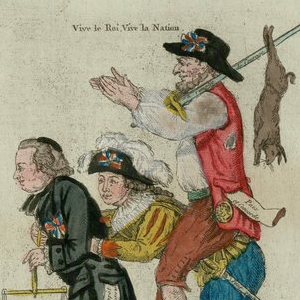Popular Culture

Oath of the New Horaces
Social discrimination against old regime elites continued in this parody of a famous painting prior to the French Revolution, The Oath of the Horatii, by Jacques–Louis David which focused on the courage of three brothers who thrust their arms bravely forward to signal their willingness t

I Was Sure We Would Have Our Turn
Class solidarity was never universal, as this print celebrates the victory of the peasantry over the nobility and clergy.

Awakening of the Third Estate
With the Bastille being destroyed in the background, a member of the Third Estate breaks his shackles. Here, the clergy and nobility recoil in fear, thereby emphasizing the conflict between the estates during the French Revolution.

General Federation of the French
This image provides a visual overview of the Festival of Federation of 14 July 1790.
Source Collection: Social Causes of the French Revolution
Instead of bringing unity and a quick, political resolution to the questions of 1789, as intended by its originators, the Revolution was producing further conflicts. What had happened? Had the revolutionaries expected too much?
Tension between Rich and Poor
The Marquis de Mirabeau, a well–educated nobleman, worried about the migration of French nobles to the cities and the passing of lands into the hands of "new men," wealthy commoners without a sense of paternal obligation toward the peasants on that land.
Beaumarchais’s Understandings of Inequality
Like his predecessors of earlier generations, playwright Pierre–Augustin Caron de Beaumarchais—who became an important figure of the late Enlightenment because of the controversy surrounding his work The Marriage of Figaro [1784]—believed that a truly rational society would not tolerate
Montesquieu’s Attack on the Nobility
In his Persian Letters, published anonymously and abroad in 1721, Charles–Louis de Sécondat, Baron de Montesquieu, president of the Parlement of Bordeaux and a noble himself, made a scathing critique of nobility that set the tone for the philosophes’ attack on the inequality of eighteent
Voltaire’s Understanding of Inequality
This passage from François–Marie Arouet, pen–named Voltaire, who was perhaps the best–known writer of the eighteenth century, illustrates the spirit of investigation of the Enlightenment.
A Bread Riot
Bread was the basic staple of most people’s diets, and variations in the price of bread were keenly felt by the poor, especially by women who most frequently bought bread in the marketplace.